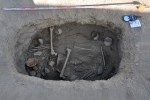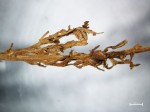 An ancient grave unearthed in Jiayi cemetery in China’s Turpan Basin contains the remains of man covered in cannabis plants. Radiocarbon dating found that the man was buried between 2,400 to 2,800 years ago. The remains of a man about 35 years of age at the time of his death were laid to rest on a wooden bed with his head on a reed pillow. Thirteen female cannabis plants, all of them close to three feet long, were laid diagonally on the man’s body. The roots placed below his pelvis, the tops reaching his chin and going up the left side of his face.
An ancient grave unearthed in Jiayi cemetery in China’s Turpan Basin contains the remains of man covered in cannabis plants. Radiocarbon dating found that the man was buried between 2,400 to 2,800 years ago. The remains of a man about 35 years of age at the time of his death were laid to rest on a wooden bed with his head on a reed pillow. Thirteen female cannabis plants, all of them close to three feet long, were laid diagonally on the man’s body. The roots placed below his pelvis, the tops reaching his chin and going up the left side of his face.
 About 240 graves have been excavated in Jiayi cemetery. Archaeologists believe it was a burial ground of the Subeixi culture which lived in the oasis between 3,000 and 2,000 years ago. Cannabis has been found in other graves in the Turpan Basin before, most notably a solid two pounds of seeds and powdered leaves found in a shaman’s burial in 2008, have been found in graves from this period before, but this is the first time entire plants have survived and the first time they’ve been found in a shroud configuration.
About 240 graves have been excavated in Jiayi cemetery. Archaeologists believe it was a burial ground of the Subeixi culture which lived in the oasis between 3,000 and 2,000 years ago. Cannabis has been found in other graves in the Turpan Basin before, most notably a solid two pounds of seeds and powdered leaves found in a shaman’s burial in 2008, have been found in graves from this period before, but this is the first time entire plants have survived and the first time they’ve been found in a shroud configuration.
The plants are in excellent condition, good enough to answer key questions about how cannabis was grown and used for funerary purposes in the region.
Since previous cannabis finds in Turpan burials consisted only of plant parts, it has been difficult for researchers to determine whether the plant was grown locally or obtained through trade with neighboring regions.
The plants in the Jiayi burial, however, were found lying flat on the man’s body, leading archaeologists to conclude that the cannabis had been fresh—and therefore local—when it was harvested for the burial.
In addition, while nearly all of the flowering heads of the 13 female plants had been cut off before they were placed on the body, a few that remained were nearly ripe and contained some immature fruit, suggesting that the plants were collected—and that the burial occurred—in late summer.
 The surviving flowering heads also provide clues to the role of cannabis in the Turpan cultures. The fibrous plants might have been valued for their usability in textile and rope-making, for example, rather than inhaled or eaten to alter consciousness. No hemp textiles or artifacts have been found, however, and the buds found in the Jiayi grave are rich in “hairs” THC-heavy hairs, suggesting that they were grown at least in part for their psychoactive properties.
The surviving flowering heads also provide clues to the role of cannabis in the Turpan cultures. The fibrous plants might have been valued for their usability in textile and rope-making, for example, rather than inhaled or eaten to alter consciousness. No hemp textiles or artifacts have been found, however, and the buds found in the Jiayi grave are rich in “hairs” THC-heavy hairs, suggesting that they were grown at least in part for their psychoactive properties.
The study of the cannabis in the Jiayi grave has been published in the journal Economic Botany and can be read here for a fee (unless you have an institutional login).